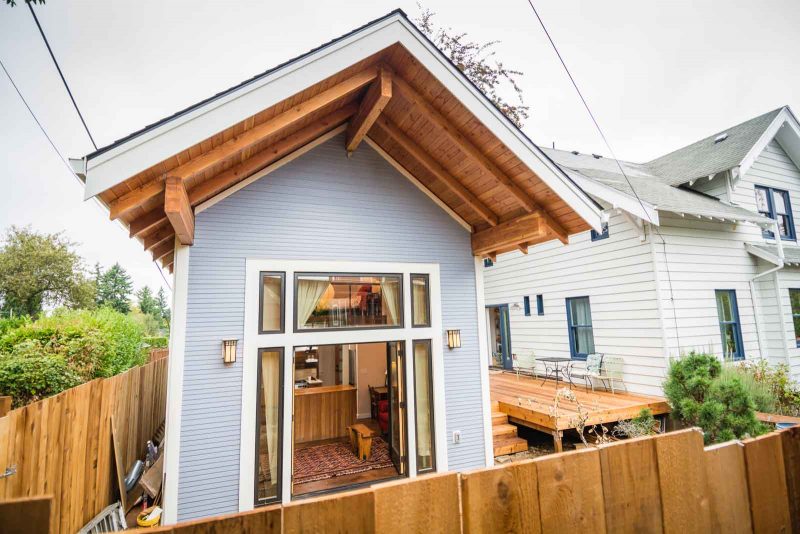
Last December, my wife, Angela, and I moved into a 2-bedroom, 850-square-foot apartment. It may not sound like much, but it was life changing for us. After working and living together in a one-bedroom apartment, we now had the space to work with some privacy, the opportunity to take the next step in growing our family by getting a dog, and could finally stop worrying about the ever-growing list of untended-to maintenance concerns in our last apartment. It was a big deal for us.
Our move also meant a new neighborhood — Kensington. To me and Angela, our 7-unit apartment building a few blocks north of El Cajon Boulevard fit right in. Sprinkled amongst the single-family homes, cottages and a few other apartments on our street, it seemed like a modest building that a group of young professionals could proudly call home. That is why it was such a surprise when we heard some of our neighbors refer to the type of building we live in as the nightmare scenario that could result from San Diego’s housing policies.
In October 2020, in order to comply with state law and address our well-documented housing supply crisis and climate emergency, San Diego’s previous City Council unanimously approved an update to its land development code to encourage the development of accessory dwelling units. These are simply smaller residences located on the same lot as a single-family home.
This wasn’t a wild idea either. As the American Planning Association explains, accessory dwelling units “have the potential to increase housing affordability (both for homeowners and tenants), create a wider range of housing options within the community, enable seniors to stay near family as they age, and facilitate better use of the existing housing fabric in established neighborhoods.” That is why, even in a time of intense political division, progressives, moderates and conservatives on the 2020 City Council approved the policy, and groups ranging from the Chamber of Commerce to the Climate Action Campaign expressed support.
Despite professional consensus about their benefits, these small homes have become an object of significant ire by some in communities I represent. Concerns have ranged from questions about affordability, to impacts on parking and infrastructure, to fears that the homes will destroy San Diego’s historic neighborhoods. In many cases, critics have referred to the possibility that property owners will maximize on the city’s accessory dwelling unit policy to build “backyard apartment buildings.”
More specifically, some have said these homes will lead to a new generation of “Huffman six-packs” taking over neighborhoods like Kensington and Talmadge. There is no doubt that for some, this reference, to buildings constructed decades ago by local developer Ray Huffman, is meant to paint a picture of backyards filling with buildings that do not fit the aesthetics of the community. However, it has also become clear there is a subsection of the opponents of these homes who seem even more concerned about who will live in those buildings — folks who make too little money, families with too many people and those who will change the character of the community.
As someone who ran on a platform to create “Opportunity for All” and desires San Diego to be an inclusive community that welcomes all people to all neighborhoods, this aversion to what some see as the wrong type of new neighbor is deeply concerning. And it hit home for me when I noticed the logo embedded in front of my apartment building: “Ray Huffman Const. Inc. Contractor.” It turns out our home is exactly what some of my neighbors are fighting against.
None of this is to say the current policy is perfect. After months of research and community engagement, I have put forward a proposal to address some excellent points raised by constituents. We should strengthen affordability requirements, take steps to manage on-street parking for residents while proactively encouraging transit use. We cannot ignore valid concerns about already strained infrastructure and we must stem the tide of corporations exploiting our communities and ensure wealth-building opportunities benefit San Diegans. And, of course, neighborhood character matters.
I believe these modifications can make San Diego a model for the nationwide effort championed by those, including the Biden Administration, who seek to make historically exclusive neighborhoods inclusive while honoring the existing fabric of communities.
The changes San Diego must make won’t always be comfortable. However, as new neighbors arrive in new homes, I hope folks remember that what may seem like a too small, too expensive apartment to those fortunate enough to purchase homes in a different era could be a lifechanging step up the housing ladder to a hardworking millennial couple with a cute pup. The couple in that apartment will care for our neighbors and support local businesses. And to us, that apartment is a place we can call home.

